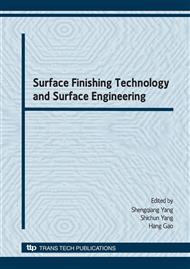p.137
p.141
p.147
p.155
p.161
p.167
p.173
p.179
p.185
Experimental Validation of the ‘Trap’ Effect of the Semibonded Abrasive Grinding Plate
Abstract:
The semibonded abrasive machining technique is expected to get high surface integrity and processing efficiency attributed to the „trap‟ effect which can reduce or even eliminate the surface damage induced by the larger particles. The goal of the work is to validate the „trap‟ effect by the experiments of semibonded and loose abrasive machining under the conditions of adding and not adding the larger particles. Free surface damage monocrystal silicon wafers after polishing are adopted as workpieces, and 1000# SiC as abrasive particles while 180# SiC as the larger particles. The cast iron plate is used as grinding plate in the loose abrasive machining and different bond concentration semibonded abrasive grinding plate SSB-1 and SSB-2 are used as grinding plates in semibonded abrasive machining. The roughness Rv and SEM photos of workpieces surface are tested to evaluate the extent of „trap‟ effect. The result shows that the semibonded abrasive grinding plate has the „trap‟ effect. The shore hardness value of the semibonded abrasive grinding plate can be used to be one parameter to evaluate the degree of the ‟trap‟ effect of the semibonded abrasive grinding plate.
Info:
Periodical:
Pages:
161-166
Citation:
Online since:
July 2008
Authors:
Price:
Сopyright:
© 2008 Trans Tech Publications Ltd. All Rights Reserved
Share:
Citation:


